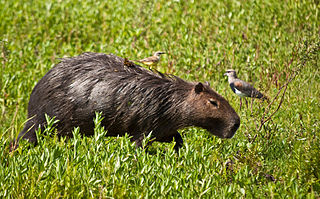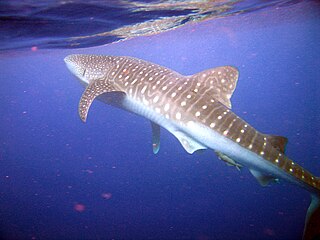
A peccary is a medium-sized pig-like hoofed mammal of the family Tayassuidae. They are found throughout Central and South America, Trinidad in the Caribbean, and in the southwestern area of North America. They usually measure between 90 and 130 cm in length, and a full-grown adult usually weighs about 20 to 40 kg.

Suina is a suborder of omnivorous, non-ruminant artiodactyl mammals that includes the pigs and peccaries. A member of this clade is known as a suine. Suina includes the family Suidae, termed suids, known in English as pigs or swine, as well as the family Tayassuidae, termed tayassuids or peccaries. Suines are largely native to Africa, South America, and Southeast Asia, with the exception of the wild boar, which is additionally native to Europe and Asia and introduced to North America and Australasia, including widespread use in farming of the domestic pig subspecies. Suines range in size from the 55 cm (22 in) long pygmy hog to the 210 cm (83 in) long giant forest hog, and are primarily found in forest, shrubland, and grassland biomes, though some can be found in deserts, wetlands, or coastal regions. Most species do not have population estimates, though approximately two billion domestic pigs are used in farming, while several species are considered endangered or critically endangered with populations as low as 100. One species, Heude's pig, is considered by the International Union for Conservation of Nature to have gone extinct in the 20th century.

The genus Hydrochoerus contains two living and two extinct species of rodents from South America, the Caribbean island of Grenada, and Panama. Capybaras are the largest living rodents in the world. The genus name is derived from the Greek ὕδωρ plus χοίρος.

The Chacoan peccary or tagua is the last extant species of the genus Catagonus; it is a peccary found in the Gran Chaco of Paraguay, Bolivia, and Argentina. Approximately 3,000 remain in the world. It is believed to be the closest living relative to the extinct genus Platygonus.

The collared peccary is a species of artiodactyl (even-toed) mammal in the family Tayassuidae found in North, Central, and South America. They are commonly referred to as javelina, saíno, or báquiro, although these terms are also used to describe other species in the family. The species is also known as the musk hog. In Trinidad, it is colloquially known as quenk.

The white-lipped peccary is a peccary found in Central and South America. Most of its range is in rainforests, but it is also known from a wide range of other habitats such as dry forests, grasslands, mangrove, Cerrado, and dry xerophytic areas. It lives in herds of 20–300 individuals that typically take up about 120 km2 (46 sq mi) to fully function. Members of this species are omnivorous, feeding mostly on fruit, and are usually found traveling great distances to obtain it. If this resource is in demand and difficult to find, peccaries eat leaves, stems, or animal parts. White-lipped peccaries have several unique attributes that allow them to stay with and identify their herd, which is essential for their survival in the wild.

Sistema Ox Bel Ha is a cave system in Quintana Roo, Mexico. It is the longest explored underwater cave in the world and ranks fourth including dry caves. As of May 2017 the surveyed length is 270.2 kilometers (167.9 mi) of underwater passages. There are more than 140 cenotes in the system.
The giant peccary was a purported fourth species of peccary, first reported to have been seen in Brazil in 2000 by Dutch naturalist Marc van Roosmalen. In 2003 German natural history filmmaker Lothar Frenz and he filmed a group and gathered a skull which later served as the type (INPA4272). It had been known locally as caitetú-mundè, which Roosmalen et al. state the locals claimed was Tupí and meant "the collared peccary that is bigger and goes in pairs", as opposed to caitetú-de-bando, "the collared peccary that goes in herds". It was formally described in 2007, but the scientific evidence for its species status was quickly questioned, which also was one of the reasons for its initial evaluation as data deficient by IUCN in 2008. A review in 2011 moved the giant peccary into synonymy with the collared peccary, which was followed by the IUCN the same year.

Serra da Cutia National Park is a national park in the state of Rondônia, Brazil.
Surameryx is an extinct genus of herbivorous even-toed ungulates originally described as belonging to the extinct family Palaeomerycidae. A single species, S. acrensis, was described from the Late Miocene of the Madre de Dios Formation, South America. It was originally interpreted as one of the few northern mammals that entered South America before the Pliocene. However, both its identification as a member of the family Palaeomerycidae and claims about its Miocene age were subsequently challenged.

The flora and fauna of Honduras reflects the country's geographical location inside the tropics. This has allowed for diverse species of plants and animals to be adapted, but some of them are now in danger of extinction. This has posed the Honduran government, offices and nature organizations to look after the protection of the local environment, like the creation of nature reserves.

The Madeira-Tapajós moist forests (NT0135) is an ecoregion in the Amazon basin. It is part of the Amazon biome. The ecoregion extends southwest from the Amazon River between its large Madeira and Tapajós tributaries, and crosses the border into Bolivia. In the south it transitions into the cerrado biome of Mato Grosso. In the state of Rondônia it contains some of the most degraded land of the Amazon basin.
Catagonus stenocephalus is an extinct species of peccary that lived in South America during the Late Pleistocene. Fossils have been found in Brazil, Argentina and Bolivia. It is commonly known as the narrow-headed peccary due to its long and markedly convex rostrum.









